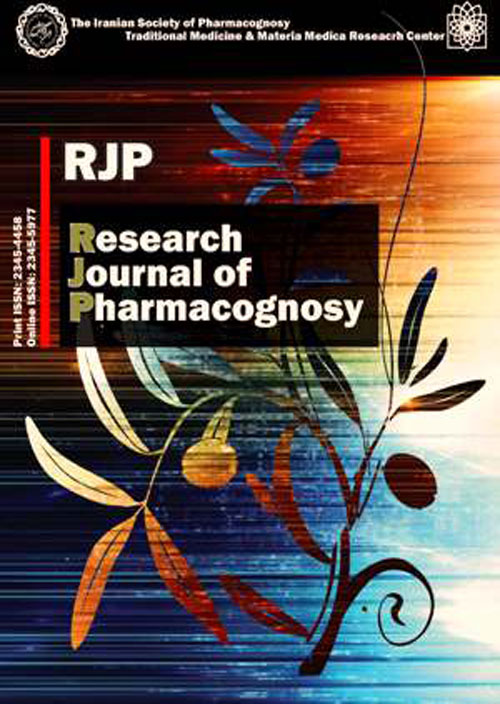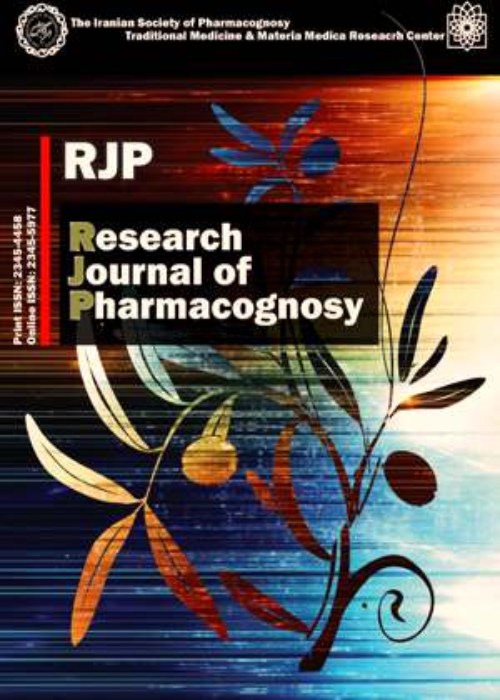فهرست مطالب

Research Journal of Pharmacognosy
Volume:9 Issue: 4, Autumn 2022
- تاریخ انتشار: 1401/07/30
- تعداد عناوین: 8
-
-
Pages 1-11Background and objectives
Croton macrostachyus Hochst ex. Delile (Euphorbiaceae) is a medicinal plant used as a traditional medicine for treating infectious diseases in Ethiopia. This study was aimed for investigating the phytochemicals, in vitro antibacterial and molecular docking of the Croton macrostachyus roots extract.
MethodsSilica gel column chromatographic separations afforded four known compounds. In vitro antibacterial activity of the isolated compounds, (1-4), and extracts of C. macrostachyus were evaluated against four human reference pathogens. Insilco molecular docking was performed for isolated compounds against two target proteins of Escherichia coli DNA gyrase B (PDB: 6F86) and Staphylococcus aureus Sortase A (PDB: 1T2P).
ResultsFrom the root extract of C. macrostachyus, four known compounds of lupeol (1), β-sitosterol (2), stigmasterol (3), and linoleic acid (4) were isolated and characterized. The extracts and isolated compounds exhibited in vitro antibacterial activity. Molecular docking results revealed that the isolated compounds interacted with the target proteins with the minimum binding energy ranging from -7.38 kCal/mol to -5.57 kCal/mol against DNA gyrase B and -7.40 kCal/mol to -5.54 kCal/mol against Sortase A.
ConclusionOur study proved that extracts and isolated compounds possess potential antibacterial activity, and the findings support the use of C. macrostachyus as a traditional medicine for treating skin infections, cough, respiratory tract problems, stomachache, and influenza virus by local people in Ethiopia.
Keywords: antibacterial activity, Croton macrostachyus, molecular docking, phytochemicals -
Pages 13-20Background and objectives
Treatment with root extract of valerian can reduce anxiety neurosis symptoms. To investigate the related therapeutic impacts, bioinformatics analysis of proteome profile of rat’s hippocampus tissue was carried out.
MethodsCytoscape V.3.9.1, and its plug-ins were applied for the construction of protein-protein interaction network of the treated subjects. NetworkAnalyzer and ClueGO+CuePedia were used to study centrality and gene ontology of the protein-protein interaction (PPI) network.
ResultsResults indicated that seven central proteins Actb, Alb, Akt1, Egfr, Tp53 as hub-bottlenecks and Th and H2afx as hub and bottleneck differentially expressed proteins (DEPs) are present in the PPI network and four corresponding biological processes. Among these seven proteins, two including tyrosine 3-monooxygenase (Th) and Histone H2A (H2afx) are differentially expressed proteins in the exposure of valerian.
ConclusionIt was found that the histone H2A and tyrosine 3-monooxygenase as central nodes are the main targets of valerian which are associated with anti-anxiety effects of the herb.
Keywords: anxiety, biomarkers, protein-protein interaction network analysis, valerian -
Pages 21-27Background and objectives
The resistance of infectious pathogens to antimicrobial drugs is an underestimated threat to public health. This rapidly developing phenomenon necessitates the discovery of new treatment strategies. Combining natural compounds with first-line antimicrobials is one treatment strategy to mitigate the emergence of resistant pathogens. Andrographolide, a diterpene lactone isolated from Andrographis paniculata has been reported to possess potent anti-infective activity. This study was conducted to evaluate the combination effect of andrographolide with first-line antimicrobial drugs to fight emerging resistance.
MethodThe minimum inhibitory concentration (MIC), fold increase in antimicrobial efficacy and fractional inhibitory concentrations (FIC) of andrographolide and ceftriaxone, ciprofloxacin, amoxicillin, metronidazole, amikacin, clindamycin and fluconazole were determined using the high throughput spot culture growth inhibition (HT-SPOTi) assay against ten isolated clinical strains; Streptococcus pyogenes, Escherichia coli, Vibrio cholerae, Pseudomonas aeruginosa, Staphylococcus aureus, Proteus mirabilis, Klebsiella pneumoniae, Enterococcus faecalis, Salmonella paratyphi B and Candida albicans.
ResultsCombination of andrographolide and the first-line antimicrobials showed various degrees of susceptibility and efficacy against the tested microorganisms with the highest MIC, 0.85 μg/mL recorded. The FICI (Fractional Inhibitory Concentration Indices) for synergy ranged between 0.00 to 0.28 depending on the microorganism and antimicrobial drug.
ConclusionUse of andrographolide with first-line antimicrobials could aid in combating the menace of resistance pathogens. However, this should be done with caution as some of the antimicrobials tested exhibited antagonistic effects.
Keywords: andrographolide, antibacterial activity, antimicrobial drugs, high-throughput screen -
Pages 29-38Background and objectives
The oleo-gum resin from Ferula gummosa</em> Bioss. is commercially important. Variability of geographic location has shown a deep effect on essential oil of different genus of plants. Thus, evaluation of oleo-gum resin of Ferula gummosa</em> from different locations is important for further studies. In the present study, phytochemicals profile of essential oil of oleo-gum resins from F. gummosa</em> in different geographic location and various bioclimates of Iran, were studied.
MethodsThe oleo-gum resin of F. gummosa</em> was collected from different regions of Iran. The essential oils of the samples were extracted by Clevenger apparatus and were analyzed by GC-MS.
ResultsThe highest amount of essential oil compared was observed in the samples from Damghan area (24.0%), Firuzkuh area (22%) and Kalat-e-Naderi area (22%). The variability in the oil composition of different samples exhibited a notable difference in monoterpenes content from 39.15 % to 87.48%. Based on GC-MS analysis, the major components were β</em>-pinene (5.11-63.80 %), sabinene (3.37-30.69%), α</em>-pinene (4.43-12.72%) and δ</em>-carene (2.38-10.23 %). The highest concentrations of β</em>-pinene (63.80%) and sabinene (30.69%) were observed in the Shiraz and Torbat-e-Jam essential oils, respectively. The highest amounts of α</em>-pinene (12.72%) and δ-</em>carene (10.23%) were recorded in Firuzkuh and Shiraz areas, respectively.
ConclusionSignificant variation in the component of the essential oils from different oleo-gum resins can be used to improve the knowledge about the endemic medicinal plants.
Keywords: volatile oil, Ferula gummosa, oleo-gum resin, β-pinene, sabinene -
Pages 39-47Background and objectives
Coffee as a common drink for many people has been evaluated in the preset study due to its relationship with cancer risk or prevention, regulation of cholesterol level, and anti-oxidant properties. The dysregulated genes in liver of high-fat dieted mice which were treated with coffee were evaluated via network analysis to explore molecular mechanism of the event.
MethodsData were downloaded from gene expression omnibus (GEO) and the significant differentially expressed genes (DEGs) were analyzed via protein-protein interaction (PPI) network analysis by Cytoscape V.3.7.2. The Selected DEGs were enriched via gene ontology by ClueGO. Results of PPI network analysis and gene ontology enrichment were interpreted together to find the critical genes and pathways.
ResultsHmgcr, Hmgcs1, Msmo1, Nsdhl, Lss, Fdps, Idi1, Mvd, Ppara, and Hsp90aa1 were identified as the central targeted genes while “cholesterol metabolism pathway” was introduced as the main affected pathway.
ConclusionFinal analysis led to determine Hmgcr, Hmgcs1, Msmo1, Nsdhl, Lss, Fdps, Idi1, and Mvd as key dysregulated genes which are related to the most biological terms of “cholesterol metabolism pathway”.
Keywords: cholesterol, coffee, gene expression, gene ontology, network analysis -
Pages 49-58Background and objectives
Vaginitis is one of the most common diseases in women. Oak gall and ajwain have been used in traditional Persian medicine for treatment of vaginitis. The purpose of this study was to formulate a vaginal preparation containing oak gall and ajwain and evaluate its effectiveness on the recovery and recurrence of vaginitis.
MethodsThe present pilot study is a randomized, double-blind clinical trial performed on 24 women with mixed vaginitis, including bacterial vaginitis and trichomoniasis in a gynecology center. Subjects were divided into two groups receiving herbal vaginal tablets or metronidazole vaginal tablets for 7 days. The vaginal tablets were prepared using dried extract of oak gall and essential oil from ajwain by direct compression method. Clinical signs and laboratory tests were assessed after treatment. The symptoms were evaluated on day 10, and also 4 and 12 weeks after intervention.
ResultsThere was a statistically significant difference in sexual function, and characteristics of secretions including amount, pH, odor, leukocyte count and parasite content in both groups of herbal (oak gall and ajwain) and metronidazole vaginal tablets before and after treatment (p<0.05). The group receiving herbal vaginal tablets showed significantly reduced secretion at follow-up on day 10 and after 4 weeks (p<0.05).
ConclusionIn our pilot study, herbal vaginal tablets containing oak gall and ajwain were as effective as metronidazole vaginal tablet. The results provide a good basis for future confirmatory tests.
Keywords: bacterial vaginitis, Persian medicine, Quercus infectoria, Trachyspermum ammi, Trichomonas vaginitis -
Pages 59-72
Agriculture is considered the primary source of income and livelihood in Africa. It is rational for people to look around their environment for food and medicine. The African legacy regarding the traditional use of medicinal plants is vast and diverse, due to cultural myths and economic logic. This review briefly defines the neglected tropical diseases and surveys African medicinal plants used for neglected tropical diseases. In Africa, people may share several plants for similar diseases, e.g., Nicotiana tabacum </em>L. and Ricinus comminus</em> L. are used for treating Buruli ulcer infection. Folkloric African plants for the treatment of bacterial, fungal, and viral neglected tropical diseases are listed and reported in the first parts. Medicinal plants for curing parasitic neglected tropical diseases are tabulated. A plethora of medicinal plants and bioactive compounds and their preparation methods, such as macerations and boiling are reported. This report reflects the richness of Africa with medicinal plants and herbal preparations being used for the treatment of various diseases, including neglected tropical diseases. Scientific investigation of these plants has yet to be conducted to isolate the active components and determine any toxic activities. Besides, knowledge of the mechanism of action behind these beneficial effects is highly required. This review will draw the attention of pharmaceutical companies and research institutions to examine the plants presented here for further laboratory analysis and experiments.
Keywords: African plants, bioactive compounds, neglected tropical diseases, traditional African medicine -
Pages 73-81
Curcumin has various beneficial effects on human health, but its efficacy is yet to be proven in clinical trials. Curcumin has poor bioavailability, low solubility, and rapid metabolism which become the principal reasons behind the lack of curcumin efficiency in clinical trials. This review aimed to focus on nanotechnologies to improve the bioavailability of curcumin inhalation formulations. Many studies were done to improve curcumin's bioavailability by administering through nanoparticle drug carriers. Pulmonary drug delivery has some advantages such as giving a rapid onset of action and bypassing the first hepatic metabolism. Lungs also have a large area for absorption. So far, there are various methods to produce curcumin nanoformulations that are proper, stable, and effective, and are suitable to enhance curcumin pulmonary delivery in the form of liposomes, polymeric and solid lipid nanoparticles, nano suspensions, and cyclodextrin formulations. Therefore, analysis of the various methods, to conclude the best method for curcumin pulmonary delivery is needed. In conclusion, the best method to make nanocurcumin formulation is the one that gives the most advantage and lowest toxicity. Therefore the best choices for curcumin nanoformulations are curcumin nanosuspension and cyclodextrin formulated nanocurcumin/proliposomes.
Keywords: bioavailability, inhalation, toxicity


